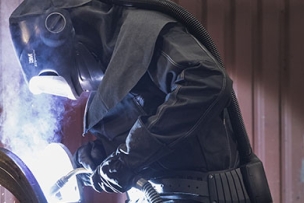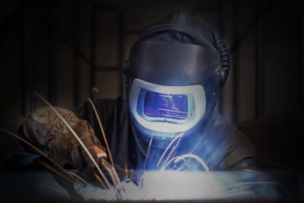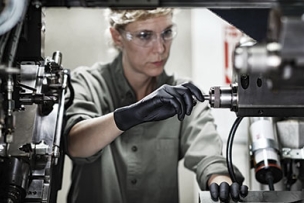Products that work as hard as you do. From the most basic to the most specialized needs, 3M offers the health and safety protection you and your workers need most, so everyone can perform at their best. We strive to deliver comfortable, well-designed personal protective equipment (PPE) that offers your workers the most effective protection available.
As wildfires continue to spark and rage year after year throughout Canada and the United States, as well as the rest of the world, it is important that workers protect themselves once the fire has been fully extinguished. Proper use of personal protective equipment (PPE) in the aftermath of a wildfire is a critical component in the safe cleanup of fire debris.
Selecting the correct items of PPE depends on several factors, most notably the anticipated hazards and the tasks to be performed. In residential and commercial cleanup situations, the severity of the damage, age of the home or building and intended remediation must be considered when determining what hazards may be present and the appropriate PPE that should be used to protect workers who have to deal with this environment.
Individuals participating in cleanup efforts may include professional workers, volunteers, and homeowners. Each group’s knowledge and experience in the use of PPE, especially respiratory protection, will vary significantly.
At a minimum, everyone needs to carefully review User Instructions and understand the proper use – and limitations – of personal protective equipment prior to initial use. For professional workers falling under the scope of U.S. OSHA, additional PPE-specific regulatory requirements, including documentation of hazard assessments and training, are also required. It is also crucial that workers follow all safe work practices and procedures for the specific site.
Potential Cleanup Hazards
Numerous hazards may be present throughout the cleanup process. Prior to beginning the work, certain considerations in addition to the actual fire damage are necessary to accurately assess all potential hazards.
For instance, the age of the home or building may suggest the potential for lead, asbestos or polychlorinated biphenyl (PCB) exposures. Homes built prior to 1980 commonly used lead-based paint coatings, asbestos-containing insulation and fireproofing as well as PCB containing caulks. Other hazardous materials, such as bulk pesticides, paints, and fuels (e.g. gasoline, propane) are common in residential areas.
Inhalation and skin contact with mold and mold spores is also a potential hazard during cleanup and restoration phases. In water-damaged homes, from attempts to put the fire out, mold growth can occur within 48 hours depending on environmental conditions. Jute-backed carpets, vinyl wall coverings, drywall, and wood products are all particularly susceptible to mold and other spores.
Using properly qualified contractors to handle and remove materials that contain asbestos, lead, PCBs, large amounts of mold or other hazardous substances is necessary in order to minimize health risks and ensure proper disposal. Other potential hazards that may commonly be encountered throughout cleanup processes may include:
- Inhalation, eye and skin contact with:
- Ash, soot, and demolition dusts containing hazardous materials
- Cleaners and disinfectants used during cleaning and restoration
- Various nuisance dusts, paint/adhesive vapors, etc. throughout the reconstruction
- Other additional materials that could cause an adverse reaction
- Operation of carbon monoxide producing equipment (e.g. pumps, generators, pressure washers) in poorly ventilated or confined areas.
- Electrical hazards from downed power lines or water damaged equipment and building electrical systems.
- Ergonomic hazards from repeated lifting, twisting, working on irregular, uneven surfaces.
- Engulfment and atmospheric hazards in open excavation, trenches, and pits.
- Heat stress and cold stress due to work outdoors.
- Fall hazards due to working at elevated heights.
- Slips and trips due to work around unstable, wet and slippery surfaces, uneven terrain and steep grades.
- Any other risks that may arise at the individual scene.
General Types of PPE
Protective measures to address recognized hazards include both safe work practices and proper use of PPE. Safe work practices are methods outlining how to perform a task with minimum risk to people and equipment. Safety professionals, government pamphlets and equipment manufacturer’s user instructions are sources of information on safe work practices. The following describes some of the general types of PPE that are commonly used in wildfire cleanups.
Head, Eye and Face Protection
Head, eye and face protection can help reduce the risk of injury due to airborne dusts, and falling or flying debris. Eye and face protection may include safety glasses or goggles as well as face shields.
Use of safety glasses with side shields should be considered minimum protection at all cleanup sites.
Unvented or indirectly vented safety goggles may be used for dusty environments or situations where splashing may occur and will fit over most prescription eyewear. Protective eyewear should meet the requirements of the American National Standards Institute (ANSI) Standard Z87.1 for safety eyewear. A small “Z87” will be stamped on the lens and/or frame if the eyewear meets the standard. Face shields are considered supplemental protection and should be used only in conjunction with safety glasses or goggles.
Hard hats should meet the requirements of ANSI Standard Z89.1 for minor impacts. Look for a sticker inside the hard hat that states it meets this standard.
Respiratory Protection Options
Respiratory protection may be necessary in all phases of a wildfire cleanup. All respirators used for cleanup should be tested and certified by the National Institute for Occupational Safety and Health (NIOSH). In general, to help reduce exposure to ash, soot and other nuisance type particles common to the cleanup, a respirator with “N95” or “P95” rated particulate filters would be appropriate. “95” is a NIOSH classification referring to the particulate filtration efficiency of the respirator (an N95 or P95 has at least 95% filtration efficiency).
Fire or smoke-related odors may require a particulate respirator with additional activated carbon cartridges. Disposable particulate respirators are also available with a carbon layer built-in to help reduce exposure to airborne dusts as well as provide nuisance odor relief.
N95 and P95 air-purifying respirators do not filter all by-products of combustion, such as carbon monoxide, and they do not supply oxygen. They should not be used in confined spaces, where high levels of carbon monoxide or low oxygen levels may be present. A safety professional or certified industrial hygienist should be called in to assess these situations and make site-specific recommendations.
It is important to note that certain tasks may require a higher level of respiratory protection. Cleanups involving homes with potential lead, asbestos, PCB or heavy mold contamination typically require a Class 100 filter (e.g., P100) with a negative pressure half or full facepiece respirator, or a Powered Air Purifying Respirator with high efficiency (HE) filters. OSHA has specific respirator requirements for both lead and asbestos.
The respirator manufacturer or a health and safety professional should be consulted if there is any question regarding respirator selection or use or if any of the dangerous conditions outlined above are present. Users must also understand respirator capabilities, as well as limitations, and follow the user instructions in order to receive the assigned level of protection. Misuse of any respiratory protection device may result in sickness or death. 3M encourages you to contact them for technical assistance when selecting respiratory PPE.
Workplace/Occupational Respirator Applications
For professional or hired cleanup workers, respirators must be used in accordance with OSHA’s Respiratory Protection Standard 29 CFR 1910.134. Mandatory use of respirators requires a respiratory program be established by the employer. Program elements include: selection, employee training, fit testing, medical evaluations, maintenance and inspection, and recordkeeping.
Volunteers/Homeowners Respirator Applications
Volunteers and homeowners should, at a minimum, be aware of basic information on the use and limitations of respirators. The following guidelines are offered for non-occupational users of respiratory protection during clean-up:
- Volunteers and homeowners should never seek to use respirators for hazardous uses.
- If volunteering, check with the organization/agency to determine if respirator use is required, or if they have a respirator program.
- If the organization is not providing respirators, ask if respiratory protection is needed for the anticipated work.
- If a homeowner is using the respirator, contact the local department of health or the respirator manufacturer if assistance is needed selecting a respirator.
Everyone using the respirator must always read and understand the product’s User Instructions and must follow the respirator manufacturer’s instructions for proper respirator donning and doffing procedures. A user seal check is required each time the respirator is worn. Also, check instructions to determine if there are any time-use limitations for the respirator. Misuse of any respiratory protection device, including improper donning and doffing, may result in sickness or death.
Hearing Protection
Hearing protection is usually necessary when operating heavy machinery or power tools. Both earplugs and earmuffs are available. Hearing protectors are also available that physically connect to portable radio systems, or provide all-in-one, fully contained wireless protective communication solutions.
Protective Clothing, Gloves, and Boots
Protective clothing, gloves, and boots, or “head-to-toe” protection, requires consideration of the types of contaminants, environmental, and work conditions to be encountered. Selection criteria may need to address both chemical and physical protection, such as the following:
- Preventing skin contact, while maintaining durability and dryness
- Site conditions and/or demolition
- Heat stress and cold stress
- Worker visibility particularly high traffic or low visibility areas
- Electrical hazards
- Task-specific protective clothing, such as welding and cutting
Consideration of specific U.S. OSHA regulations and for other types of safety-related equipment, such as fall protection, lockout/tagout, and confined space, may also be necessary in order to provide complete personal protection.
Pre-planning for personal protection is essential at a wildfire cleanup. An understanding of the hazards involved and the types of protective equipment available will help ensure worker safety is maintained. 3M invites you to check out their helpful wildfire cleanup infographic and technical bulletin that outlines the hazards and PPE solutions. For help selecting the right safety equipment and for more helpful information about how to deal with your situation after a wildfire, please contact one of 3M's health and safety specialists at 1-800-243-4630.
Previously Featured on 3M's Resources page.







